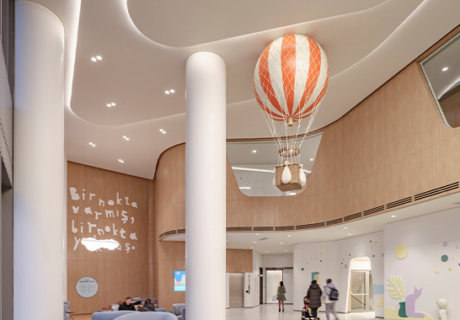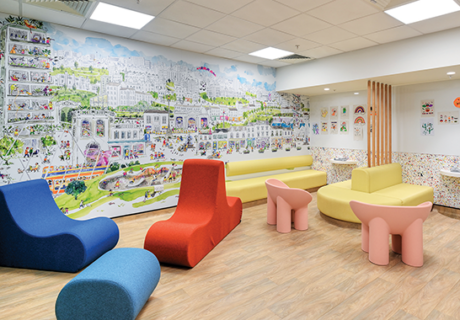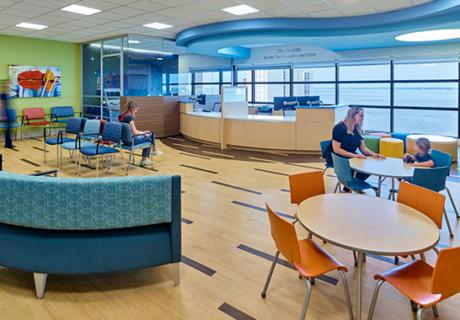Screen Time At MassGeneral Hospital For Children
Design firms spend a lot of time creating positive distractions in patient rooms, waiting spaces, and respite areas, all in an effort to reduce stress and create welcoming environments for patients and families. In pediatric facilities, those efforts are especially meaningful and can range from child-friendly artwork and graphics to interactive play sets and virtual reality experiences. Recently, Payette (Boston) embarked on a project that helped stretch the firm’s approach to these strategies as well as its understanding of the value of patient education.
The project began as the brainchild of 12-year-old Wendy Wooden, a patient at MassGeneral Hospital for Children (MGHFC) in Boston, with a complex medical history resulting in long stays at the hospital. A couple of years ago, a family friend reached out to Wendy and her mom, Darcy Daniels, for advice on preparing for a hospital visit. The young patient was inspired to share her knowledge and experiences and decided to write a short narrative to help familiarize young patients and their families with what they might face inside the ED to alleviate some trepidation.
She worked with her mother to write “You Are Here: Wendy’s Welcome to the ED” and teamed up with MGHFC’s family advisory council to publish the story as an educational booklet for families to read when they first arrived at the hospital. However, after the ED was renovated in 2015, the hospital decided to go paperless and didn’t want to pursue the printed project. While providing the material in digital format was considered, the resources necessary to create a video animation weren’t available. That’s when Payette stepped in.
Stuart Baur, an associate principal at Payette, knew Darcy Daniels and heard about the situation. Baur reached out to his coworkers, and more than 20 people stepped up to volunteer more than 1,500 hours over 10 months to turn Wendy’s story into a short cartoon that walks kids through the ED, being admitted, and heading home. The firm’s in-house talent provided everything from originally composed music and photography to digitized sketches, including a character of Wendy in her likeness. They also helped coach her through a recording session so she could narrate the video.
During the nine-minute video, the animated character of Wendy is shown with a backdrop of still images and time-lapse videos of ED spaces as she talks about things like the layout of the unit, furnishings and equipment in the exam room, and what it’s like to get lab tests. The project made its debut in October 2016 and is displayed on a TV in the waiting room, by child life specialists on a tablet, and on the hospital’s YouTube page.
“It’s a well understood phenomenon that the reduction of stress and the provision of positive distractions have a direct, favorable, and measurable effect on the length of patient stays and the overall outcomes experienced by pediatric patients,” Baur says. “This project is an innovative application of technology to achieve those goals through patient education delivered in a format that both children and adults can connect with and be entertained by.”
Child life specialists at the hospital have told the firm that kids say the video is helpful in explaining the care process and that it’s “cool” that someone their age was involved in creating it.
For the firm, the project offered an opportunity to think differently about designing for care delivery. “Architects are constantly working to create physical environments that are tuned to support a wide range of human needs and emotions,” Baur says. “We’re uniquely capable of using our expertise that comes from working in the media of human emotion to create something that soothes in a time of stress and that educates in a moment of uncertainty.”









